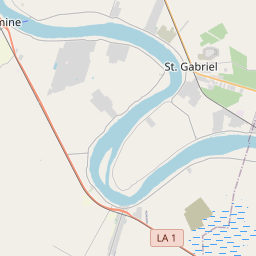Indian Camp Plantation
Historical marker location:
Carville, Louisiana
( Marker is on Point Claire Road (State Highway 141) 1.6 miles south of Marks Lane, on the right when traveling south.)
Marker installed: 1980







© OpenStreetMap contributors
Hurricane Katrina, which struck Louisiana in 2005, was one of the deadliest and costliest hurricanes in U.S. history. The storm caused widespread destruction in New Orleans and other parts of the state, and its aftermath highlighted issues of poverty, race, and government response in the United States.
About Iberville Parish
Iberville Parish Timeline
Iberville Parish is located in the southern part of the U.S. state of Louisiana. It was first settled by Europeans in the early 18th century when French explorers discovered the Mississippi River and established the colony of Louisiana. Iberville Parish was part of the original territory of the French Louisiana colony and was named after the French-Canadian explorer Pierre Le Moyne d'Iberville.
During the 19th century, the economy of Iberville Parish was primarily based on agriculture, with large plantations cultivating crops like sugar cane and cotton. The region also saw significant industrial growth with the construction of railroads and the development of a strong timber industry. The parish became an important transportation hub, connecting the Mississippi River with the rest of the country.
In the 20th century, Iberville Parish experienced both economic growth and challenges. The discovery of oil and gas fields in the area brought prosperity, attracting oil companies and creating job opportunities. However, the parish also faced difficulties during the Great Depression and the decline of the agricultural industry. Over the years, efforts have been made to diversify the economy through the establishment of new industries such as petrochemical plants and manufacturing facilities.
Today, Iberville Parish remains a vibrant and diverse community, with a mixture of rural and urban areas. The parish is home to a rich cultural heritage, with a blend of French, African, and Native American influences. Its unique history and natural beauty, including scenic bayous and historical sites, make Iberville Parish an attractive destination for visitors.
During the 19th century, the economy of Iberville Parish was primarily based on agriculture, with large plantations cultivating crops like sugar cane and cotton. The region also saw significant industrial growth with the construction of railroads and the development of a strong timber industry. The parish became an important transportation hub, connecting the Mississippi River with the rest of the country.
In the 20th century, Iberville Parish experienced both economic growth and challenges. The discovery of oil and gas fields in the area brought prosperity, attracting oil companies and creating job opportunities. However, the parish also faced difficulties during the Great Depression and the decline of the agricultural industry. Over the years, efforts have been made to diversify the economy through the establishment of new industries such as petrochemical plants and manufacturing facilities.
Today, Iberville Parish remains a vibrant and diverse community, with a mixture of rural and urban areas. The parish is home to a rich cultural heritage, with a blend of French, African, and Native American influences. Its unique history and natural beauty, including scenic bayous and historical sites, make Iberville Parish an attractive destination for visitors.
Iberville Parish Timeline
This timeline provides a glimpse into the major events and milestones that have shaped the history of Iberville Parish, Louisiana.
- 1699 - French explorer Pierre Le Moyne d'Iberville claims the area now known as Iberville Parish for France.
- 1722 - Fort Rosalie, the first European settlement in the area, is established by French colonists.
- 1763 - The Treaty of Paris cedes the Louisiana territory to Spain, including what is now Iberville Parish.
- 1800 - The Spanish return Louisiana to France under the Treaty of San Ildefonso.
- 1803 - The United States acquires Louisiana from France in the Louisiana Purchase.
- 1807 - Iberville Parish is established as one of the original 19 parishes in the newly formed state of Louisiana.
- 1848 - The town of Plaquemine becomes the parish seat.
- 1861-1865 - Iberville Parish is heavily impacted by the American Civil War.
- 1903 - The opening of the Plaquemine Lock connects the Mississippi River to the Gulf Intracoastal Waterway, boosting trade and commerce in the area.
- 1974 - The Iberville Parish school system is created as a separate entity from the Iberville Parish Police Jury.
- 2005 - Iberville Parish is severely affected by Hurricane Katrina, resulting in widespread damage and displacement of residents.